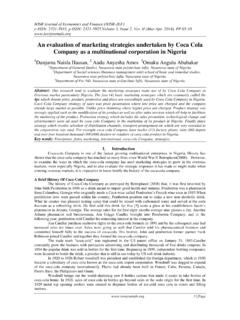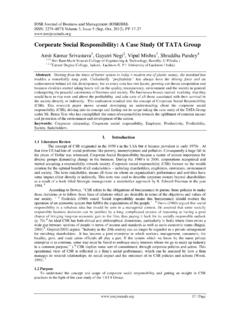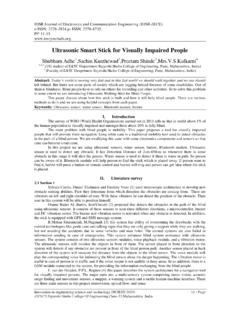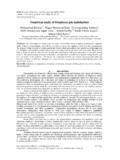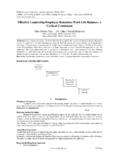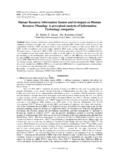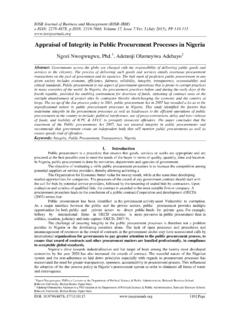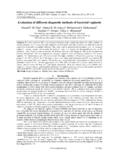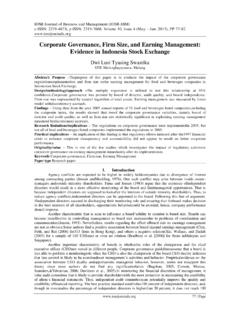Transcription of Study on Theory of Group Development; Groups and Teams
1 IOSR Journal of Business and Management (IOSR-JBM) e-ISSN: 2278-487X, p-ISSN: 2319-7668. Volume 18, Issue 2 .Ver. III (Feb. 2016), PP 58-61 DOI: 58 | Page Study on Theory of Group Development; Groups and Teams *, ** *Post Graduate in Human Resources from TISS, India, is pursuing his PhD at VIT Uuniversity, India, and holds the position of CPO at Vinayaka Missions University, India. **PhD from IIT, Madras, India, is currently the Associate Professor, at VIT University, Business School, India.
2 Abstract: This paper traces the evolution of Group development Theory beginning with the seminal work of Tuckman and thereafter. It gives an understanding how Groups are formed and what stages of development they go through to accomplish their goals. It also gives an understanding of Gersick's punctuated equilibrium, that significantly impacts the pace at which Groups work, towards accomplishing their task. The paper also distinguishes between Groups and Teams . It gives an understanding of the theoretical development of Group work process focussing on natural Groups .
3 The paper would kindle interest for empirical Study of Group development in natural Groups in corporate environment Key Words: Group development, Teams , Punctuated Equilibrium, Tuckman I. Introduction Formation of Groups and their development in achieving tasks has provided an interesting arena of Study . This paper traces evolution of Theory on Group development, and also discusses the difference between Groups and Teams . The paper helps to understand the steps in Group formation, the transition that happens as Groups move towards completion of task, and also captures the distinction between Groups and Teams .
4 Tuckman's Evolution Of Group Development Process The best known framework on Group development was developed by Tuckman (1965). Tuckman examined 50 research papers broadly covering therapy Groups , T- Groups , natural Groups , and laboratory Groups . Based on his examination of past studies, Tuckman studied the Group development from two perspectives: i. Interpersonal Group activities ii. Group task activities. In Group interpersonal activities Tuckman developed a sequential progress beginning with testing and dependence, intragroup conflict, development of Group cohesion, and functional role relatedness; while in Group task activities the sequential stages are: Orientation to the task, Emotional response to task demand, Open exchange of relevant interpretations, and emergence of solutions.
5 Tuckman postulated that the Group development consisted of 4 stages, viz., Forming, Storming, Norming, and Performing. Tuckman s Study suffered from certain limitations in that the past studies had more therapy Groups and less of natural Groups . Further the studies were not subject to much quantitative rigour. Further Study On Group Development Process Tuckman along with Mary Ann Jensen (1977) studied papers on Group development of the past 10 years to check their four step Group model Theory .
6 They examined Science Citation Index 1965 and Social Science Citation Index 1970, and examined 57 related articles. Only Runkel s (1971) Study set out to test Tuckman s hypothesis. Lucoursiere (1974) added a stage called termination, and Spitz and Sadock (1973) identified a stage called termination. Yalom (1970) had a four stage model ending with termination stage. On a review of all these studies, Tuckman decided it appropriate to add the 5th and final stage to his model - adjourning.
7 Perfect Equilibrium In Group Development Process Gersick Study (1988) presents a new Theory , on what significantly impacts the pace at which Groups work, towards accomplishing their task. He studied eight Groups across six organisations. Gersick analysis of data showed that the Group had a dramatic or revolutionary change in its pace of work, almost exactly at the midpoint. Till the midpoint the Group is in a state of inertia, staying with the framework developed in the very first meeting.
8 He saw a corollary with the concept of punctuated equilibrium in natural history Eldredge & Gould (1972). The limitations of the Study include the fact that it evolved a new hypothesis, and there was no empirical testing involved; the influence of environment as a trigger on the Group activity was noticed, but was Study on Theory of Group Development; Groups and Teams DOI: 59 | Page not studied in depth.
9 Finally, the model would only fit Teams that have an ability to change the course mid stream. The research by Romanelli and Tuckman (1994) was to empirically test punctuated equilibrium model in organisations, postulated by Gersick (1988). Until this Study only case histories of organisations like AT&T, General Radio, citibank , and Prime Computers, were used to validate Gersick Study . The hypothesis that organisational negative performance would result in revolutionary transformation could not be substantiated.
10 Otherwise analysis of data showed that change in environment, change in CEO brought about drastic changes in most parts of the organisational activity involving structure, strategy, and power distribution. Thus, Gersick s model of punctuated equilibrium was empirically tested and validated. The limitation of the Study is that the research on the model should be carried out in a more stable environment, as this Study of minicomputer producers was carried out amidst changes in technology and high competition.
